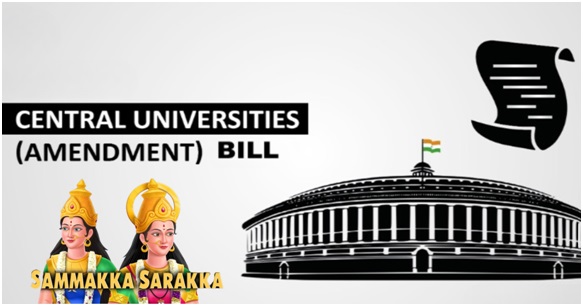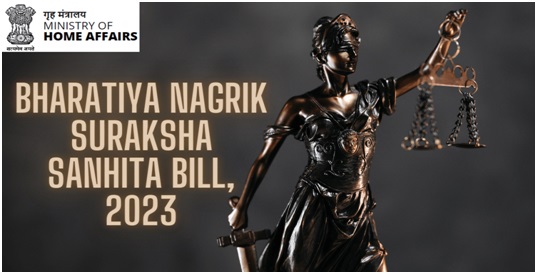Central Universities (Amendment) Bill, 2023 and the Legend of Sammakka and Sarakka (NewsOnAir)

- 06 Dec 2023
Why is it in the News?
The Lok Sabha on Wednesday (6th December 2023) took up the Central Universities (Amendment) Bill, 2023 for consideration and passing. The Bill amends the Central Universities Act, 2009, which establishes central universities for teaching and research in various states.
News Summary:
- Recently, the Lok Sabha took up the Central Universities (Amendment) Bill, 2023 for consideration and passing.
- The Bill amends the Central Universities Act, 2009, which establishes central universities for teaching and research in various states.
- The Bill seeks to establish a Central Tribal University in Telangana which will be named ‘Sammakka Sarakka Central Tribal University’.
Background:
- This legislative proposal aligns with the commitments outlined in the Andhra Pradesh Reorganisation Act, 2014.
- The 2014 Reorganisation Act resulted in the division of the former state of Andhra Pradesh into Telangana and the remaining Andhra Pradesh state.
- As per this act, both Andhra Pradesh and Telangana were promised support to establish a tribal university each.
Key Features:
- Amendment to Central Universities Act, 2009: The bill involves amendments to the Central Universities Act, 2009, a legislation enacted to establish and incorporate universities dedicated to teaching and research across various states.
- Name of the Central Tribal University: The university is named as a tribute to the legendary mother-daughter duo, Sammakka and Sarakka.
- Addressing Regional Aspirations: The establishment of the Sammakka Sarakka Central Tribal University is poised to address and fulfil regional aspirations for the foreseeable future.
- Focus on Tribal Population: The university's primary objective is to offer avenues for higher education and research facilities, with a special emphasis on serving the tribal population of India.
About the Legend of Sammakka and Sarakka:
- As per the legends, Sammakka was married to a feudal chief of the Kakatiyas dynasty, Pagididda Raju who ruled over the Warangal region.
- She had two daughters and one son - Sarakka or Saralamma, Nagulamma and Jampanna, respectively.
- In the 13th century, Saralamma succumbed in a battle against local rulers protesting tax imposition, while Sammakka vanished into the hills.
- The local (Koya) tribals believed she transformed into a vermillion casket.
The Sammakka Saralamma Jatara:
- The Sammakka Sarakka Jathara, also known as Medaram Jathara, is a biennial festival that commemorates the 13th-century battle where the mother-daughter duo actively protested against local rulers imposing taxes on the Koya tribe.
- Sammakka and Sarakka are revered as protectors of the Koya tribe, and the festival is distinctively free from Vedic or Brahmanic influences.
- During the festival, devotees take a holy dip in Jampanna Vagu, a stream and tributary of the River Godavari.
- Commencing from Medaram, situated in the Eturnagaram Wildlife Sanctuary within the Dandakaranya forest, the Jathara involves Koya tribe priests performing rituals.
- Various tribal and non-tribal communities from Andhra Pradesh, Madhya Pradesh, Chhattisgarh, Odisha, Maharashtra, Karnataka, and Jharkhand actively participated in the event.
- Recognized as the second-largest fair in India and often likened to the Kumbh Mela for tribals, the festival holds the status of a state festival declared by the Telangana government.
Political and Cultural Significance of the Sammakka Saralamma Jatara:
- The festival attracts participation from the Union Ministry of Tribal Affairs and the Telangana state government, including the Chief Minister.
- Funding has been released for community shelters and infrastructure, and the Ministry of Tourism allocated Rs. 75.88 crore for the integrated development of a tribal circuit under the Swadesh Darshan Scheme.
- This circuit encompasses Mulugu, Laknavaram, Medavaram, Tadvai, Damaravi, Mallur, and Bogatha Waterfalls, where the Sammakka-Sarakka temple is located.
- Mulugu, a reserved Scheduled Tribes (ST) assembly seat with a population of approximately 2.6 lakhs (2011 Census), holds political and cultural significance with a 75% ST population.
- The UNESCO World Heritage Site of Ramappa Temple is situated about 15 km from Mulugu.
Koya Tribe
- The Koya tribe, recognized as the largest Adivasi tribe in Telangana, holds Scheduled Tribe status in the region.
- They are dispersed across the Telugu-speaking states of Telangana and Andhra Pradesh.
- The Koyas commonly refer to themselves as Dorala Sattam (Lords group) and Putta Dora (original lords).
- In their dialect, akin to Gonds, they identify as "Koitur."
- Habitat and Livelihood: The Godavari and Sabari rivers, integral to their habitat, significantly shape the economic, social, and cultural aspects of Koya life.
- Primarily settled cultivators, they engage in the cultivation of crops like Jowar, Ragi, Bajra, and various millets.
- Language: While some Koya individuals have adopted Telugu as their primary language, others in different regions still speak the Koya dialect.
- Religion and Festivals: Key deities in Koya religious practices include Lord Bhima, Korra Rajulu, Mamili, and Potaraju.
- Major festivals for the Koyas include Vijji Pandum (seeds charming festival) and Kondala Kolupu (festival to appease Hill deities).
- Cultural Practices: During festivals and marriage ceremonies, the Koyas showcase a vibrant and robust dance known as Permakok ata (Bison horn dance).
The Bharatiya Nagrik Suraksha Sanhita Bill 2023 (NewsOnAIR)

- 14 Aug 2023
Why in the News?
- The Home Minister, Amit Shah introduces three bills namely, the Bharatiya Nyaya Sanhita 2023, the Bharatiya Nagarik Suraksha Sanhita 2023, and the Bharatiya Sakshya Bill 2023.
- The Bharatiya Nyaya Sanhita 2023 is designed to replace the Indian Penal Code of 1860, the Bharatiya Nagarik Suraksha Sanhita 2023 aims to supersede the Criminal Procedure Act, of 1898, and the Bharatiya Sakshya Bill 2023 will take the place of the Indian Evidence Act, 1872.
- The Minister emphasized that these Bills are set to revolutionize the country's criminal justice system.
- Their primary focus is on delivering justice to individuals rather than merely imposing penalties.
- These legislative measures have been meticulously developed after thorough discussions and deliberations. Notably, provisions relating to sedition will be fully removed.
- The laws have undergone 313 modifications to bolster the criminal justice system's efficacy and robustness.
What Prompted the Introduction of the Bharatiya Nagarik Suraksha Sanhita Bill?
- The culmination of Azadi ka Amrit Mahotsav on August 15, 2023, marks the commencement of India's journey from 75 to 100 years of independence, heralding the vision of a resplendent India.
- On August 15, 2022, during his address from the Red Fort, the Prime Minister of India presented the nation with the Panch Pran, or five vows, one of which is the eradication of all vestiges of subjugation.
- Spanning from 1860 to 2023, India's criminal justice system has endured under laws formulated by the British Parliament.
- In this context, the introduction of these three bills stands as an embodiment of the commitment to fulfill one of the five vows - instilling a distinct Indian essence to drive a transformative shift in the nation's criminal justice system.
What Constitutes the Code of Criminal Procedure (CrPC)?
- Established in 1973 (enforced on April 1, 1974), the CrPC stands as the primary legislation governing the procedural aspects of administering substantive criminal law in India.
- It serves to:
- Outline the mechanisms for investigating crimes,
- Facilitate the apprehension of suspected individuals,
- Facilitate the collection of evidence,
- Ascertain the guilt or innocence of the accused party, and
- Determine the appropriate punishment for those found guilty.
- Furthermore, the CrPC addresses matters such as public disturbances, prevention of offenses, and the support of family members like spouses, children, and parents.
- The Bharatiya Nagarik Suraksha Sanhita Bill 2023 aims to replace the CrPC as it currently stands.
What are the Main Amendments Proposed in the CrPC?
- Enhanced Technological Integration:
- Proceedings including trials, appeals, and depositions (including those of public servants and police officers) can be conducted through electronic means.
- Accused individuals' statements may be recorded via video conferencing.
- Summons, warrants, documents, police reports, and evidence statements can be generated in electronic format.
- Integration of Communication Devices:
- The bill introduces "communication devices" as part of electronic communication.
- Individuals may be required to produce digital evidence-containing devices upon court or police directives.
- Controlled Use of Handcuffs:
- Police officers may use handcuffs during the arrest of repeat offenders, escapees from custody, or those involved in organized crime, terrorist acts, or offenses against the state.
- Strengthened Safeguards:
- Section 41A of CrPC will be renumbered as Section 35.
- Added provision: Arrest without prior permission from a DSP isn't permitted for offenses carrying less than 3 years' punishment or if the person is over 60 years old.
- Mercy Petitions Clarified:
- Guidelines outlined for filing mercy petitions in death sentence cases.
- A 30-day window after being informed of petition disposal for submitting a mercy plea to the Governor.
- Subsequent recourse to the President within 60 days if rejected, with no further court appeal.
- Expedited Sanction to Prosecute:
- Government to decide on granting or rejecting prosecution sanction within 120 days of receiving a request.
- Inaction will be deemed as granting sanction.
- Exemptions for sexual offenses, trafficking, etc., from requiring sanction.
- Arms Possession Regulations:
- District magistrates retain power under Section 144A to prohibit arms possession during processions and mass activities to maintain public peace.
- Samples Collection Without Arrest:
- Magistrates are empowered to order samples of signature, handwriting, voice, or finger impressions for investigation without arrest.
- Police Detention and Action:
- Police are enabled to detain or remove individuals resisting preventive actions or defying orders.
- Trial in Absentia:
- In alignment with stringent anti-terror laws like UAPA, where the burden of proof is reversed.
- Accused must prove innocence rather than the state proving guilt.
- These proposed amendments aim to modernize and enhance the effectiveness of the Criminal Procedure Code while upholding safeguards and rights.
Importance of the Bharatiya Nagarik Suraksha Sanhita Bill:
- Streamlined Criminal Procedure:
- The bill seeks to consolidate and amend criminal procedure laws, establishing specific timelines for time-bound investigations, trials, and verdicts.
- This ensures a prompt and efficient dispensation of justice.
- Expedited Justice Delivery:
- The legislation stands to expedite the judicial process, leading to a swifter resolution of cases.
- Alignment with Digital India Initiative:
- The draft legislation is in sync with the Digital India campaign.
- It acknowledges digital records as admissible evidence, conferring the same legal validity and enforceability as traditional paper records.
- Enhanced Citizen-Centric Approach:
- The bill adopts a citizen-centric perspective by ensuring that First Information Reports (FIRs) are readily accessible to complainants.
- Victims are kept informed about case progress via digital channels.
- Summary Trials for Minor Offences:
- The bill introduces summary trials for minor offenses, further speeding up the legal process for less serious cases.
- Facilitation of 'Zero FIR':
- The bill allows for the lodging of a 'Zero FIR' at any police station, irrespective of jurisdiction.
- This enables swift initiation of the legal process without being bound by geographical constraints.
The Bharatiya Nagarik Suraksha Sanhita Bill aims to modernize criminal procedures, leverage technology for efficiency, prioritize citizens' access to justice, and foster a faster and more accessible legal system.
